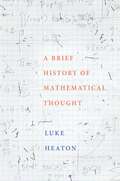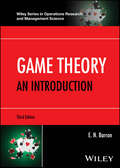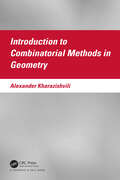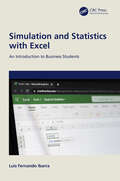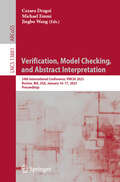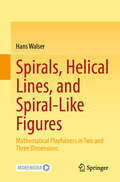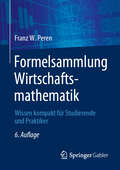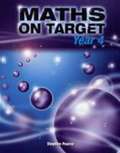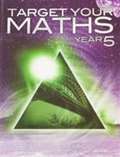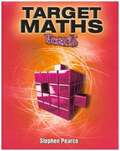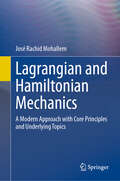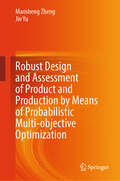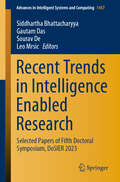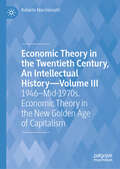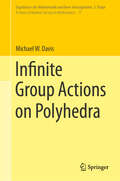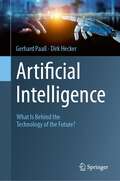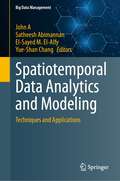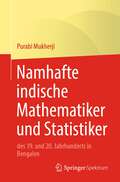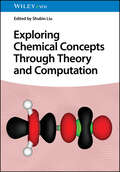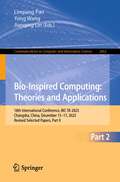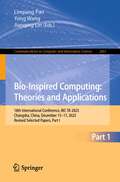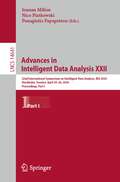- Table View
- List View
A Brief History of Mathematical Thought
by Luke HeatonAdvertisements for the wildly popular game of Sudoku often feature the reassuring words, "no mathematical knowledge required." In fact, the only skill Sudoku does require is the use of mathematical logic. For many people, anxiety about math is so entrenched, and grade school memories so haunting, that these disclaimers - though misleading - are necessary to avoid intimidating potential buyers. In A Brief History of Mathematical Thought, Luke Heaton provides a compulsively readable history that situates mathematics within the human experience and, in the process, makes it more accessible. Mastering math begins with understanding its history. Heaton's book therefore offers a lively guide into and through the world of numbers and equations-one in which patterns and arguments are traced through logic in the language of concrete experience. Heaton reveals how Greek and Roman mathematicians like Pythagoras, Euclid, and Archimedes helped shaped the early logic of mathematics; how the Fibonacci sequence, the rise of algebra, and the invention of calculus are connected; how clocks, coordinates, and logical padlocks work mathematically; and how, in the twentieth century, Alan Turing's revolutionary work on the concept of computation laid the groundwork for the modern world. A Brief History of Mathematical Thought situates mathematics as part of, and essential to, lived experience. Understanding it does not require the application of various rules or numbing memorization, but rather a historical imagination and a view to its origins. Moving from the origin of numbers, into calculus, and through infinity, Heaton sheds light on the language of math and its significance to human life.
Game Theory: An Introduction (Wiley Series in Operations Research and Management Science #1)
by E. N. BarronAuthoritative and quantitative approach to modern game theory with applications from areas including economics, political science, computer science, and engineering Game Theory acknowledges the role of mathematics in making logical and advantageous decisions in adversarial situations and provides a balanced treatment of the subject that is both conceptual and applied. This newly updated and revised Third Edition streamlines the text to introduce readers to the basic theories behind games in a less technical but still mathematically rigorous way, with many new real-world examples from various fields of study, including economics, political science, military science, finance, biological science, and general game playing. The text introduces topics like repeated games, Bayesian equilibria, signaling games, bargaining games, evolutionary stable strategies, extensive games, and network and congestion games, which will be of interest across a wide range of disciplines. Separate sections in each chapter illustrate the use of Mathematica and Gambit software to create, analyze, and implement effective decision-making models. A companion website contains the related Mathematica and Gambit data sets and code. Solutions, hints, and methods used to solve most problems to enable self-learning are in an Appendix. Game Theory includes detailed information on: The von Neumann Minimax Theorem and methods for solving any 2-person zero sum matrix game. Two-person nonzero sum games solved for a Nash Equilibrium using nonlinear programming software or a calculus method. Nash Equilibria and Correlated Equilibria. Repeated games and punishment strategies to enforce cooperation Games in Extensive Form for solving Bayesian and perfect information games using Gambit. N-Person nonzero sum games, games with a continuum of strategies and many models in economics applications, duels, auctions, of Nash Equilibria, and the Stable Matching problem Coalitions and characteristic functions of cooperative games, an exact nucleolus for three-player games, bargaining Game theory in evolutionary processes and population games A trusted and proven guide for students of mathematics, engineering, and economics, the Third Edition of Game Theory is also an excellent resource for researchers and practitioners in economics, finance, engineering, operations research, statistics, and computer science.
Introduction to Combinatorial Methods in Geometry
by Alexander KharazishviliThis book offers an introduction to some combinatorial (also, set-theoretical) approaches and methods in geometry of the Euclidean space Rm. The topics discussed in the manuscript are due to the field of combinatorial and convex geometry. The author’s primary intention is to discuss those themes of Euclidean geometry which might be of interest to a sufficiently wide audience of potential readers. Accordingly, the material is explained in a simple and elementary form completely accessible to the college and university students. At the same time, the author reveals profound interactions between various facts and statements from different areas of mathematics: the theory of convex sets, finite and infinite combinatorics, graph theory, measure theory, classical number theory, etc. All chapters (and also the five Appendices) end with a number of exercises. These provide the reader with some additional information about topics considered in the main text of this book. Naturally, the exercises vary in their difficulty. Among them there are almost trivial, standard, nontrivial, rather difficult, and difficult. As a rule, more difficult exercises are marked by asterisks and are provided with necessary hints.The material presented is based on the lecture course given by the author. The choice of material serves to demonstrate the unity of mathematics and variety of unexpected interrelations between distinct mathematical branches.
Introduction to Combinatorial Methods in Geometry
by Alexander KharazishviliThis book offers an introduction to some combinatorial (also, set-theoretical) approaches and methods in geometry of the Euclidean space Rm. The topics discussed in the manuscript are due to the field of combinatorial and convex geometry. The author’s primary intention is to discuss those themes of Euclidean geometry which might be of interest to a sufficiently wide audience of potential readers. Accordingly, the material is explained in a simple and elementary form completely accessible to the college and university students. At the same time, the author reveals profound interactions between various facts and statements from different areas of mathematics: the theory of convex sets, finite and infinite combinatorics, graph theory, measure theory, classical number theory, etc. All chapters (and also the five Appendices) end with a number of exercises. These provide the reader with some additional information about topics considered in the main text of this book. Naturally, the exercises vary in their difficulty. Among them there are almost trivial, standard, nontrivial, rather difficult, and difficult. As a rule, more difficult exercises are marked by asterisks and are provided with necessary hints.The material presented is based on the lecture course given by the author. The choice of material serves to demonstrate the unity of mathematics and variety of unexpected interrelations between distinct mathematical branches.
Simulation and Statistics with Excel: An Introduction to Business Students
by Luis Fernando IbarraThe use of simulation techniques has increased in importance in recent history, and simulation activities are an important resource for advanced preparation for the organization and execution of events. When formal mathematics is not enough, simulation may be the only option capable of approximating solutions. Simulation and Statistics with Excel: An Introduction to Business Students offers a non-rigorous and practical tour of the simulation procedure on computers, using a versatile and accessible resource, the Microsoft Excel spreadsheet. This book covers the concepts essential to understanding the basic principles and approaches of statistical simulation, allowing for the study of complex systems. Aimed at students in business and operational research beginning to use simulation as an instrument for understanding existing or proposed processes, this book will lay solid foundations in understanding simulation experimentation.Key Features: Provides a basis to understand the approaches and principles of simulator experiments. Uses a universal and easily accessible resource. Introduces simple examples to teach the fundamentals of simulation.
Simulation and Statistics with Excel: An Introduction to Business Students
by Luis Fernando IbarraThe use of simulation techniques has increased in importance in recent history, and simulation activities are an important resource for advanced preparation for the organization and execution of events. When formal mathematics is not enough, simulation may be the only option capable of approximating solutions. Simulation and Statistics with Excel: An Introduction to Business Students offers a non-rigorous and practical tour of the simulation procedure on computers, using a versatile and accessible resource, the Microsoft Excel spreadsheet. This book covers the concepts essential to understanding the basic principles and approaches of statistical simulation, allowing for the study of complex systems. Aimed at students in business and operational research beginning to use simulation as an instrument for understanding existing or proposed processes, this book will lay solid foundations in understanding simulation experimentation.Key Features: Provides a basis to understand the approaches and principles of simulator experiments. Uses a universal and easily accessible resource. Introduces simple examples to teach the fundamentals of simulation.
Verification, Model Checking, and Abstract Interpretation: 24th International Conference, VMCAI 2023, Boston, MA, USA, January 16–17, 2023, Proceedings (Lecture Notes in Computer Science #13881)
by Cezara Dragoi Michael Emmi Jingbo WangThis book constitutes the proceedings of the 24th International Conference on Verification, Model Checking, and Abstract Interpretation, VMCAI 2023, which took place in Boston, USA, in January 2023. The 17 full papers presented in this book were carefully reviewed and selected from 34 submissions. The contributions deal with program verification, model checking, abstract interpretation, program synthesis, static analysis, type systems, deductive methods, decision procedures, theorem proving, program certification, debugging techniques, program transformation, optimization, and hybrid and cyber-physical systems.
Spirals, Helical Lines, and Spiral-Like Figures: Mathematical Playfulness in Two and Three Dimensions
by Hans WalserIn this book you will discover the mathematical patterns and regularities of various spirals, helixes and spiral-like figures. Their geometric aspects and connections are presented in a visually appealing way and are supplemented as best as possible with analytical aspects and representations. Using examples from technology and nature, you will learn about round, square, golden and spherical spirals and examine their curvature behavior and other exciting properties. The examples are arranged thematically and the book has a modular structure so that the individual chapters can be read largely independently of each other. It is therefore a valuable resource for students, pupils, (prospective) teachers, those interested in mathematics and those who want to become one.Additional animations are available with the SN More Media app: simply download the SN More Media app free of charge, scan an image or a link with the play button and immediately play the animation on your smartphone or tablet.The translation was done with the help of artificial intelligence. A subsequent human revision was done primarily in terms of content.
Formelsammlung Wirtschaftsmathematik: Wissen kompakt für Studierende und Praktiker
by Franz W. PerenDiese etablierte Formelsammlung enthält und erklärt mathematische Formeln innerhalb ökonomischer Zusammenhänge, wie sie in den Wirtschaftswissenschaften und in der wirtschaftswissenschaftlichen Praxis unbedingt notwendig sind. Das Verständnis der Formeln und deren praktische Anwendung werden durch nützliche Hilfen und erklärliche Beispiele sinnvoll unterstützt, so dass der Kontext wirtschaftsmathematischer Formeln klar und verständlich dargestellt wird. Diese Formelsammlung ist ein unverzichtbares Tool für Studierende der Wirtschaftswissenschaften, aber auch ein nützliches Nachschlagewerk für Verantwortliche aus Wirtschaft, Politik und Lehre. Die Inhalte wurden für die 6. Auflage teilweise überarbeitet und ergänzt.
Target your Maths Year 5
by Stephen PearceThe new Target Your Maths series has been written to fully support the renewed 2014 National Curriculum Framework. The structure as set out in Appendices II and III of the Answer Book enables teachers to develop concepts progressively throughout the year and provides pupils with frequent opportunities to consolidate previous learning. Each single or double page lesson in this book is divided into four sections: Introduction: the learning intention expressed as a target and, where necessary, clearly worked examples. Section A: activities based upon work previously covered. This generally matches the requirements for Year 4 pupils. This section can be used to remind children of work previously covered, as well as providing material for the less confident child. Section B: activities based upon the requirements for Year 5 pupils. Most children should be able to work successfully at this level. Section C: activities providing extension material for the faster workers and for those who need to be moved quickly onto more challenging tasks. The work in this section generally matches the requirements for Year 6 pupils. Problems in Section C can also provide useful material for discussion in the plenary session.
Lagrangian and Hamiltonian Mechanics: A Modern Approach with Core Principles and Underlying Topics
by José Rachid MohallemThis book serves as a textbook for an analytical mechanics course, a fundamental subject of physics, that pays special attention to important topics that are not discussed in most standard textbooks. Readers are provided with a clear understanding of topics that are usually inaccessible to the undergraduate level and that are critical to learning Lagrangian and Hamiltonian mechanics. Each chapter also includes worked problems and solutions, as well as additional exercises for readers to try. This book begins with the fundamentals of analytical mechanics, concisely introducing readers to the calculus of variations, Hamilton’s Principle, and Lagrange’s equations. While presenting readers with these core topics, the author uses an intuitive approach to delve into essential questions, such as where Galilean invariance lies in Lagrangian mechanics and how Hamilton’s Principle of Least Action encompasses Newton’s three laws, interesting conclusions that often go unnoticed. Infact, Hamilton’s principle is taken throughout as the very origin of classical physical laws, and the choice of appropriate Lagrangians in each case as the real theoretical challenge, meaning that forms of Lagrangian which differ from the standard one are not mere curiosities but, instead, the general rule. This book clarifies common misunderstandings that students face when learning the subject and formally rationalizes concepts that are often difficult to grasp. In addition, the final chapter provides an introduction to a Lagrangian field theory for those interested in learning more advanced topics. Ideal for upper undergraduate and graduate students, this book seeks to teach the intrinsic meaning of the principles and equations taught in an analytical mechanics course and convey their usefulness as powerful theoretical instruments of modern physics.
Robust Design and Assessment of Product and Production by Means of Probabilistic Multi-objective Optimization
by Maosheng Zheng Jie YuThis book develops robust design and assessment of product and production from viewpoint of system theory, which is quantized with the introduction of brand new concept of preferable probability and its assessment. It aims to provide a new idea and novel way to robust design and assessment of product and production and relevant problems. Robust design and assessment of product and production is attractive to both customer and producer since the stability and insensitivity of a product’s quality to uncontrollable factors reflect its value. Taguchi method has been used to conduct robust design and assessment of product and production for half a century, but its rationality is criticized by statisticians due to its casting of both mean value of a response and its dispersion into one index, which doesn’t characterize the issue of simultaneous optimization of above two independent sub-responses sufficiently for robust design, so an appropriate approach is needed. The preference or role of a response in the evaluation is indicated by using preferable probability as the unique index. Thus, the rational approach for robust design and assessment of product and production is formulated by means of probabilistic multi-objective optimization, which reveals the simultaneous optimization of both mean value of a response and its dispersion in manner of joint probability. Besides, defuzzification and fuzzification measurements are involved as preliminary approaches for robust assessment, the latter provides miraculous treatment for the 'target the best' case flexibly.
Recent Trends in Intelligence Enabled Research: Selected Papers of Fifth Doctoral Symposium, DoSIER 2023 (Advances in Intelligent Systems and Computing #1457)
by Siddhartha Bhattacharyya Gautam Das Sourav De Leo MrsicThis book gathers extended versions of papers presented at DoSIER 2023 (Fifth Doctoral Symposium on Intelligence Enabled Research, held at Cooch Behar Government Engineering College, West Bengal, India, during December 20–21, 2023). The papers address the rapidly expanding research area of computational intelligence, which, no longer limited to specific computational fields, has since made inroads in signal processing, smart manufacturing, predictive control, robot navigation, smart cities, and sensor design, to name but a few. Presenting chapters written by experts active in these areas, the book offers a valuable reference guide for researchers and industrial practitioners alike and inspires future studies.
Economic Theory in the Twentieth Century, An Intellectual History—Volume III: 1946–Mid-1970s. Economic Theory in the New Golden Age of Capitalism
by Roberto MarchionattiThis book, set out over four-volumes, provides a comprehensive history of economic thought in the 20th century. Special attention is given to the cultural and historical background behind the development of economic theories, the leading or the peripheral research communities and their interactions, and a critical appreciation and assessment of economic theories throughout these times.Volume III addresses economic theory in the period of the new golden age of capitalism, between the years from the end of the Second World War to the mid1970s, which saw the establishment of the new mainstream, in particular in its Harvard-MIT-Cowles version. It was the period of the pre-eminence of the Neoclassical Keynesian Synthesis—the theoretical core of the period’s dominant school of thought.This work provides a significant and original contribution to the history of economic thought and gives insight to the thinking of some of themajor international figures in economics. It will appeal to students, scholars and the more informed reader wishing to further their understanding of the history of the discipline.
Infinite Group Actions on Polyhedra (Ergebnisse der Mathematik und ihrer Grenzgebiete. 3. Folge / A Series of Modern Surveys in Mathematics #77)
by Michael W. DavisIn the past fifteen years, the theory of right-angled Artin groups and special cube complexes has emerged as a central topic in geometric group theory. This monograph provides an account of this theory, along with other modern techniques in geometric group theory. Structured around the theme of group actions on contractible polyhedra, this book explores two prominent methods for constructing such actions: utilizing the group of deck transformations of the universal cover of a nonpositively curved polyhedron and leveraging the theory of simple complexes of groups. The book presents various approaches to obtaining cubical examples through CAT(0) cube complexes, including the polyhedral product construction, hyperbolization procedures, and the Sageev construction. Moreover, it offers a unified presentation of important non-cubical examples, such as Coxeter groups, Artin groups, and groups that act on buildings. Designed as a resource for graduate students and researchers specializing in geometric group theory, this book should also be of high interest to mathematicians in related areas, such as 3-manifolds.
Artificial Intelligence: What Is Behind the Technology of the Future?
by Gerhard Paaß Dirk HeckerArtificial Intelligence (AI) is already present in our daily routines, and in the future, we will encounter it in almost every aspect of life – from analyzing X-rays for medical diagnosis, driving autonomous cars, maintaining complex machinery, to drafting essays on environmental problems and drawing imaginative pictures. The potentials of AI are enormous, while at the same time many myths, uncertainties and challenges circulate that need to be tackled. The English translation of the book “Künstliche Intelligenz – Was steckt hinter der Technologie der Zukunft?” originally published in German (Springer Vieweg, 2020), this book is addressed to the general public, from interested citizens to corporate executives who want to develop a better and deeper understanding of AI technologies and assess their consequences. Mathematical basics, terminology, and methods are explained in understandable language. Adaptations to different media such as images, text, and speech and the corresponding generative models are introduced. A concluding discussion of opportunities and challenges helps readers evaluate new developments, demystify them, and assess their relevance for the future.
Spatiotemporal Data Analytics and Modeling: Techniques and Applications (Big Data Management)
by John A Satheesh Abimannan El-Sayed M. El-Alfy Yue-Shan ChangWith the growing advances in technology and transformation to digital services, the world is becoming more connected and more complex. Huge heterogeneous data are generated at rapid speed from various types of sensors. Augmented with artificial intelligence and machine learning and internet of things, latent relations, and new insights can be captured helping in optimizing plans and resource utilization, improving infrastructure, and enhancing quality of services. A “spatial data management system” is a way to take care of data that has something to do with space. This could include data such as maps, satellite images, and GPS data. A temporal data management system is a system designed to manage data that has a temporal component. This could include data such as weather data, financial data, and social media data. Some advanced techniques used in spatial and temporal data management systems include geospatial indexing for efficient querying and retrieval of location-based data, time-series analysis for understanding and predicting temporal patterns in datasets like weather or financial trends, machine learning algorithms for uncovering hidden patterns and correlations in large and complex datasets, and integration with Internet of Things (IoT) technologies for real-time data collection and analysis. These techniques, augmented with artificial intelligence, enable the extraction of latent relations and insights, thereby optimizing plans, improving infrastructure, and enhancing the quality of services. This book provides essential technical knowledge, best practices, and case studies on the state-of-the-art techniques of artificial intelligence and machine learning for spatiotemporal data analysis and modeling. The book is composed of several chapters written by experts in their fields and focusing on several applications including recommendation systems, big data analytics, supply chains and e-commerce, energy consumption and demand forecasting,and traffic and environmental monitoring. It can be used as academic reference at graduate level or by professionals in science and engineering related fields such as data science and engineering, big data analytics and mining, artificial intelligence, machine learning and deep learning, cloud computing, and internet of things.
Namhafte indische Mathematiker und Statistiker: des 19. und 20. Jahrhunderts in Bengalen
by Purabi MukherjiDieses Buch bietet eine umfassende Darstellung der Geschichte der indischen Mathematiker und Statistiker und deckt viele fehlende Teile der wissenschaftlichen Darstellung der mathematischen und statistischen Forschung in Bengalen (heute Westbengalen), Indien, im 19. und 20. Jahrhundert ab. Dieses Buch gibt einen kurzen historischen Überblick über die Einrichtung der ersten beiden Abteilungen an einer indischen Universität, in denen Lehre und Forschung für Graduierte eingeführt wurden. Dies war eine einzigartige Auszeichnung für die 1857 gegründete Universität von Kalkutta. Auch die Gründung des weltberühmten Indischen Statistischen Instituts (ISI) in Kalkutta wird kurz beschrieben. Leben und Werk der 16 Pioniere der mathematischen Wissenschaft, die an oben genannten Institutionen und dem ersten indische Institut für Technologie (IIT) in Indien wirkten, werden in klarer Sprache dargestellt. Einige herausragende Gelehrte, die am ISI ausgebildet wurden, Indien aber dauerhaft verließen, werden in einem eigenen Kapitel kurz vorgestellt. Dieses Buch schließt eine seit langem bestehende Lücke in der Geschichte der modernen indischen Mathematik, was das Buch für Forscher in der Geschichte der Wissenschaft und der Mathematik sehr nützlich machen wird. Das Buch ist in sehr klarer Sprache geschrieben, mit wenig mathematischem oder statistischem Jargon, was es auch für allgemeine Leser mit Interesse an Wissenschaftsgeschichte, selbst mit nicht-mathematischem, nicht-statistischem Hintergrund, sehr lesbar macht. Dieses Buch ist eine klare Darstellung des Kampfes und des Erfolges der Forscher in den mathematischen Wissenschaften in Bengalen (einem wichtigen Teil des kolonialen Indiens), die vor der internationalen Gemeinschaft der mathematischen Wissenschaftler enthüllt wird. Echte Kenner werden den Wert des Buches zu schätzen wissen, da es viele vorherrschende Missverständnisse ausräumen wird.Die Übersetzung wurde mit Hilfe von künstlicher Intelligenz durchgeführt. Eine anschließende menschliche Überarbeitung erfolgte vor allem in Bezug auf den Inhalt.
Exploring Chemical Concepts Through Theory and Computation
by Shubin LiuExploring Chemical Concepts Through Theory and Computation Deep, theoretical resource on the essence of chemistry, explaining a variety of important concepts including redox states and bond types Exploring Chemical Concepts Through Theory and Computation provides a comprehensive account of how the three widely used theoretical frameworks of valence bond theory, molecular orbital theory, and density functional theory, along with a variety of important chemical concepts, can between them describe and efficiently and reliably predict key chemical parameters and phenomena. By comparing the three main theoretical frameworks, readers will become competent in choosing the right modeling approach for their task. The authors go beyond a simple comparison of existing algorithms to show how data-driven theories can explain why chemical compounds behave the way they do, thus promoting a deeper understanding of the essence of chemistry. The text is contributed to by top theoretical and computational chemists who have turned computational chemistry into today’s data-driven and application-oriented science. Exploring Chemical Concepts Through Theory and Computation discusses topics including: Orbital-based approaches, density-based approaches, chemical bonding, partial charges, atoms in molecules, oxidation states, aromaticity and antiaromaticity, and acidity and basicityElectronegativity, hardness, softness, HSAB, sigma-hole interactions, charge transport and energy transfer, and homogeneous and heterogeneous catalysisElectrophilicity, nucleophilicity, cooperativity, frustration, homochirality, and energy decompositionChemical concepts in solids, excited states, spectroscopy and machine learning, and catalysis and machine learning, as well as key connections between related concepts Aimed at both novice and experienced computational, theoretical, and physical chemists, Exploring Chemical Concepts Through Theory and Computation is an essential reference to gain a deeper, more advanced holistic understanding of the field of chemistry as a whole.
Exploring Chemical Concepts Through Theory and Computation
by Shubin LiuExploring Chemical Concepts Through Theory and Computation Deep, theoretical resource on the essence of chemistry, explaining a variety of important concepts including redox states and bond types Exploring Chemical Concepts Through Theory and Computation provides a comprehensive account of how the three widely used theoretical frameworks of valence bond theory, molecular orbital theory, and density functional theory, along with a variety of important chemical concepts, can between them describe and efficiently and reliably predict key chemical parameters and phenomena. By comparing the three main theoretical frameworks, readers will become competent in choosing the right modeling approach for their task. The authors go beyond a simple comparison of existing algorithms to show how data-driven theories can explain why chemical compounds behave the way they do, thus promoting a deeper understanding of the essence of chemistry. The text is contributed to by top theoretical and computational chemists who have turned computational chemistry into today’s data-driven and application-oriented science. Exploring Chemical Concepts Through Theory and Computation discusses topics including: Orbital-based approaches, density-based approaches, chemical bonding, partial charges, atoms in molecules, oxidation states, aromaticity and antiaromaticity, and acidity and basicityElectronegativity, hardness, softness, HSAB, sigma-hole interactions, charge transport and energy transfer, and homogeneous and heterogeneous catalysisElectrophilicity, nucleophilicity, cooperativity, frustration, homochirality, and energy decompositionChemical concepts in solids, excited states, spectroscopy and machine learning, and catalysis and machine learning, as well as key connections between related concepts Aimed at both novice and experienced computational, theoretical, and physical chemists, Exploring Chemical Concepts Through Theory and Computation is an essential reference to gain a deeper, more advanced holistic understanding of the field of chemistry as a whole.
Bio-Inspired Computing: 18th International Conference, BIC-TA 2023, Changsha, China, December 15–17, 2023, Revised Selected Papers, Part II (Communications in Computer and Information Science #2062)
by Linqiang Pan Yong Wang Jianqing LinThe two-volume set CCIS 2061 and 2062 constitutes the refereed post-conference proceedings of the 18th International Conference on Bio-Inspired Computing: Theories and Applications, BIC-TA 2023, held in Changsha, China, during December 15–17, 2023.The 64 revised full papers presented in these proceedings were carefully reviewed and selected from 168 submissions. The papers are organized in the following topical sections: Volume I: Evolutionary Computation and Swarm Intelligence; and Membrane Computing and DNA ComputingVolume II: Machine Learning and Applications; and Intelligent Control and Application.
Bio-Inspired Computing: 18th International Conference, BIC-TA 2023, Changsha, China, December 15–17, 2023, Revised Selected Papers, Part I (Communications in Computer and Information Science #2061)
by Linqiang Pan Yong Wang Jianqing LinThe two-volume set CCIS 2061 and 2062 constitutes the refereed post-conference proceedings of the 18th International Conference on Bio-Inspired Computing: Theories and Applications, BIC-TA 2023, held in Changsha, China, during December 15–17, 2023.The 64 revised full papers presented in these proceedings were carefully reviewed and selected from 168 submissions. The papers are organized in the following topical sections: Volume I: Evolutionary Computation and Swarm Intelligence; and Membrane Computing and DNA ComputingVolume II: Machine Learning and Applications; and Intelligent Control and Application.
Advances in Intelligent Data Analysis XXII: 22nd International Symposium on Intelligent Data Analysis, IDA 2024, Stockholm, Sweden, April 24–26, 2024, Proceedings, Part I (Lecture Notes in Computer Science #14641)
by Ioanna Miliou Nico Piatkowski Panagiotis PapapetrouThe two volume set LNCS 14641 and 14642 constitutes the proceedings of the 22nd International Symposium on Intelligent Data Analysis, IDA 2024, which was held in Stockholm, Sweden, during April 24-26, 2024. The 40 full and 3 short papers included in the proceedings were carefully reviewed and selected from 94 submissions. IDA is an international symposium presenting advances in the intelligent analysis of data. Distinguishing characteristics of IDA are its focus on novel, inspiring ideas, its focus on research, and its relatively small scale.
